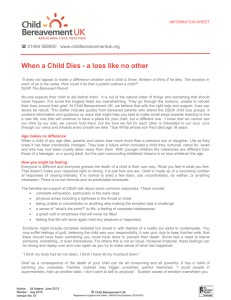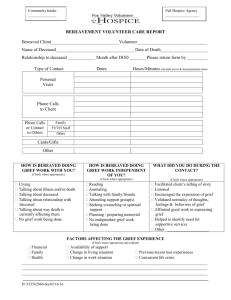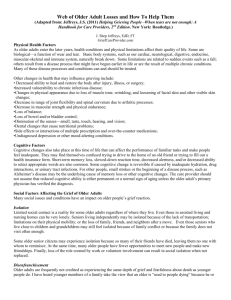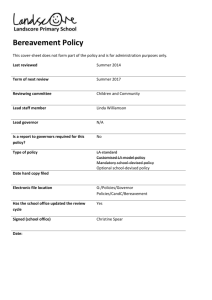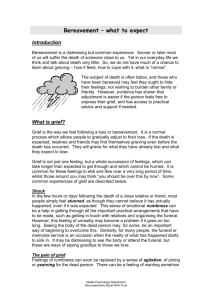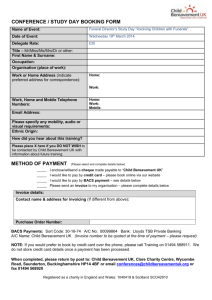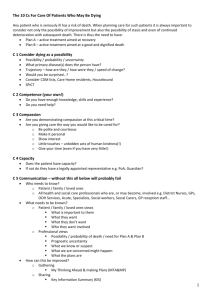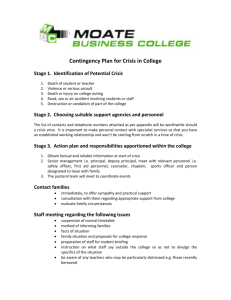Working With Bereaved Children
advertisement
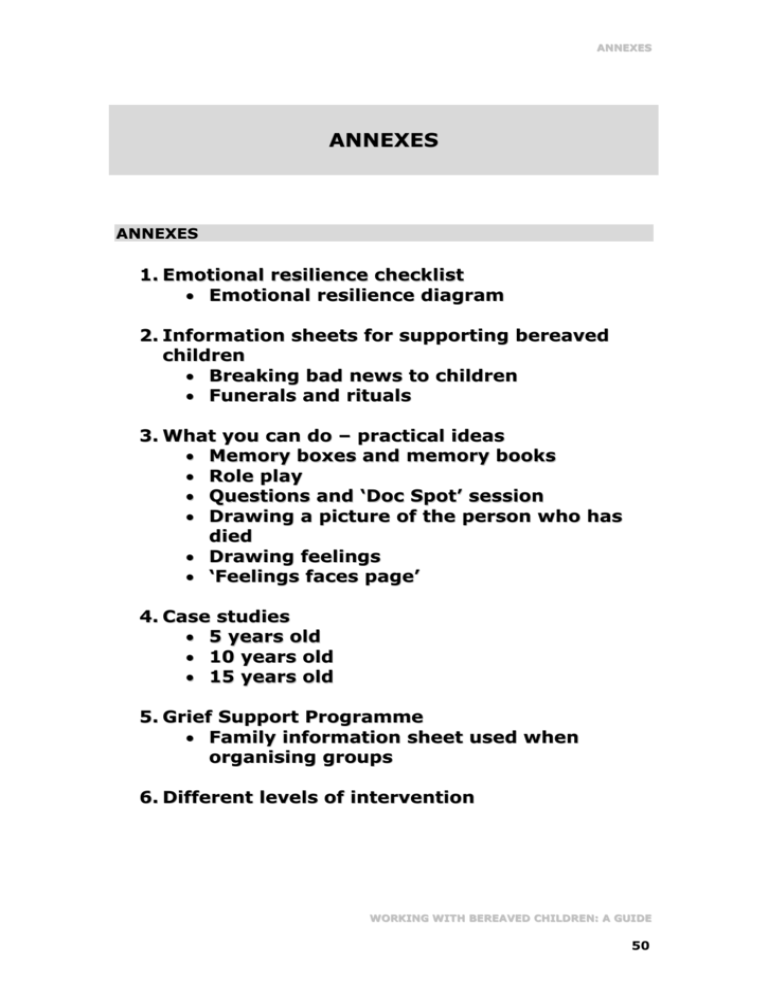
ANNEXES ANNEXES ANNEXES 1. Emotional resilience checklist Emotional resilience diagram 2. Information sheets for supporting bereaved children Breaking bad news to children Funerals and rituals 3. What you can do – practical ideas Memory boxes and memory books Role play Questions and ‘Doc Spot’ session Drawing a picture of the person who has died Drawing feelings ‘Feelings faces page’ 4. Case studies 5 years old 10 years old 15 years old 5. Grief Support Programme Family information sheet used when organising groups 6. Different levels of intervention WORKING WITH BEREAVED CHILDREN: A GUIDE 50 ANNEXES ANNEX 1 EMOTIONAL RESILIENCE CHECKLIST The following issues, which impact upon emotional resilience, need to be considered when working with a child who is faced with bereavement and loss. However, it is not definitive and should be used as a guideline only. A. AGE AND DEVELOPMENTAL/COGNITIVE UNDERSTANDING OF THE CHILD Children can understand that someone is missing from a very young age. However, children may not understand the permanence of death if they are young. They may display attachment anxiety or ‘seeking’ behaviour as a response to loss. It is important to use age and cognitively appropriate language and means of engagement. It is also important to use the right words even if the child is very young, so as not to confuse them e.g. “The person has died” rather than saying “The person has gone away”. Also the correct name for the disease should be used. B. COMMUNICATION PATTERNS WITHIN THE FAMILY Does the family make time for discussions about sensitive issues including death? Do they involve the child in these discussions and use appropriate language? - Does the family have a closed/open pattern of communication? Do family members allow for the feelings of the child to be validated, especially if they are different to the ‘family norm’? Is the family able to make allowances for the anxieties of the child during their bereavement? Who is the decision maker in the family in terms of communication? Who is the ‘holder of information’? C. CHILD'S RELATIONSHIP WITH THE PERSON WHO DIED What is the individual relationship that each child in a family has with the patient/person who has died? How much face-to-face contact did the child have with the person before they died? Infrequent contact does not mean a lesser relationship or a lesser bereavement response. Where a child loses a sibling, there is also a loss of position and identity in the family as a sibling. There may be associated difficulties if a child had a difficult or ambivalent relationship with the person who died. For example, if a child wished the WORKING WITH BEREAVED CHILDREN: A GUIDE 51 ANNEXES person was dead and then they died, the child may feel he is omnipotent and have associated feelings of guilt. D. WHAT IS THE CHILD’S UNDERSTANDING OF THE SITUATION? What information has been given to the child, when and how much? Is the parent struggling with the reality of the information? Information needs to be provided to the child in a way that is manageable (i.e. little and often), while keeping the child appropriately up to date. Does the child understand what he has been told? Does the child's understanding supersede that of the parents? For example, does the child ‘know’ that the parent is dying, but the parent is himself in denial? What might also impede the parent's own understanding or ability share appropriate information e.g. intellectual impairment of parent, mental health problems, and drug and alcohol dependency? E. SUPPORT NETWORKS AND SYSTEMS Does the family have support networks? It is important to identify and use both formal and informal networks and structures e.g. both family based and agency based. Are the networks fully informed of the situation? Are they able to help the child at their own pace? It is important to ensure appropriate communication between the family and their networks to ensure consistency of support and information. If the major decision maker dies, can the systems support the existing parent to provide security within the family? Where there is an awareness of limited networks and support systems, it is important to plan in advance. One important area is the child’s future care. If possible, it is beneficial to involve the dying parent in that process. F. ARE THERE ANY PREVIOUS OR CONCURRENT LOSSES IN THE CHILD’S LIFE Previous or concurrent losses include divorce, separation, a house move and previous deaths. It is important to understand how people have dealt with previous losses what is their emotional resilience? What was the child's response and involvement in previous losses? Have they worked through these other losses appropriately enough or is there significant unresolved loss? Do they employ emotional blocking as a means of coping? The current loss can compound previous experience and can exacerbate subsequent reactions. Does the family have a sense of emotional and physical stability? Is disruption and ‘moving’ used as a means of coping with difficult emotional situations? Do significant family members have a history of running away from conflict rather than making a sustained effort at resolving painful issues? WORKING WITH BEREAVED CHILDREN: A GUIDE 52 ANNEXES F. OTHER SOCIAL ISSUES How do significant individual family members cope with distressing events? Are they able to contain their own emotions sufficiently to function in an appropriate way? Is there a history of emotional instability separate to current experience? Other relevant factors to consider include mental health, substance misuse, domestic violence, unemployment and financial issues. Do family members cope by investing in anger towards other people including children? Is there a history of recurrent relationships or remarriage. Are there issues for children regarding ‘absent parents’ following divorce/separation/secondary losses. H. ANTICIPATED AND UNEXPECTED BEREAVEMENT ANTICIPATED BEREAVEMENT Difficulties associated with the prolonged periods of illness and disease prior to death may result in people feeling both drained but also relieved when someone dies because of the emotional energy that is expended. There may also be some associated guilt with feeling that way. The bereavement process is protracted, beginning when the person is diagnosed. It is important for children and families to engage in normal activities at the same time as facing the bereavement. Maintained peer interaction is important for children. UNANTICIPATED BEREAVEMENT Where the death is sudden, reactions include sheer shock and disbelief. There is also a lack of preparation and no possibility of saying goodbye. There is a risk that the child will be marginalized by the adult’s experience as a result of his/her feelings. An awareness of a child possibly distancing themselves and withdrawing either emotionally or physically may lead a parent to believe that a child is coping, but this may set up a pattern of emotional difficulties in the future. Suicide raises other complexities as there is an element of ‘choice’ around that person’s death. Children may struggle with why a parent would choose to die and choose to leave them. They may believe that they could have saved person’s life and experience a loss of self esteem because they could not prevent it. The child may display vigilant behaviour around the surviving parent, and searching behaviours - searching for clues on why the parent died, recalling situations, playing the events over. I. INVOLVEMENT OF CHILD IN ENDINGS There should be an awareness of families who do not involve the child, especially as often this is an indication that the child’s feelings are not being validated. It is important for the child to be involved in the family process of saying goodbye. It is OK for a child to see their parent cry. WORKING WITH BEREAVED CHILDREN: A GUIDE 53 ANNEXES Children’s magical thinking needs to be considered in terms of the finality of death. J. OTHER How long after the initial period of bereavement is normal functioning impaired? e.g. school attendance, appropriate role of parent. Does the parent and child have the ability to live their life without the bereavement being the major focus? K. CHILD PROTECTION ISSUES Programme organisers need to have a good understanding of local statutory agencies and NGO’s and the role they play in supporting families and advocating for the rights of a child. If possible, there should be good, well established networking arrangements between relevant groups and agencies. Grief Support Programmes cannot (and do not have to) physically support everyone who is bereaved. There should be criteria set down for appropriate referrals as well as an awareness that families with specific additional issues, may fit into another agency’s remit that is specialising in that area. It is important that families are ‘signposted’ (directed) to other agencies where their needs can be better met elsewhere. Grief should not be ‘professionalised’ – i.e. only dealt with by one agency. It is vital that workers are able to observe whether a parent’s emotional strengths are so depleted that they are unable to provide emotional or practical support to a child through the bereavement process. Other statutory agencies need to be made aware of the situation, not only in cases of physical and verbal aggression, but in situations where a parent’s normal functioning is so impaired that the child is being neglected. It is important for workers to have an awareness of possible indicators of abuse and neglect. If such severe difficulties arise, workers should encourage parents to seek medical or specialist psychological help. Medication should not be ruled out at this point as it may be needed as a short term measure. L. CONFIDENTIALITY 100% confidentiality cannot be maintained when working with children and families. There must be an ongoing awareness both of issues that affect children and families aside from their bereavement, as well as other organisations or agencies that are working with this vulnerable population. Workers need to be alert to a child being unnecessarily afraid, being unable to concentrate, losing weight, displaying overly sexualized behaviour and being unkempt. Child protection issues (where the child is at risk) override the need to maintain confidentiality. Issues may also need to be raised with other agencies if a child has become the main carer for the parent who is dying. WORKING WITH BEREAVED CHILDREN: A GUIDE 54 ANNEXES EMOTIONAL RESILIENCE DIAGRAM WHAT IS THE AGE AND DEVELOPMENTAL/ COGNITIVE UNDERSTANDING OF THE CHILD? WHAT ARE THE COMMUNICATION PATTERNS WITHIN THE FAMILY? WAS THE CHILD EXCLUDED FROM THE ‘ENDING’? WHAT BEHVIOUR IS THE CHILD DISPLAYING? IS THIS ‘ANTICIPATED’ OR ‘UNANTICIPATED’ BEREAVEMENT? Have you considered all of these issues? ARE THERE ANY OTHER RELEVANT SOCIAL ISSUES THAT ARE IMPACTING UPON THE CHILD? HAS THE CHILD SUFFERED ANY PREVIOUS LOSS? WHAT IS THE CHILD’S RELATIONSHIP WITH THE PERSON WHO IS ILL/HAS DIED? WHAT IS THE CHILD’S UNDERSTANDING OF THE SITUATION? WHAT ARE THE CHILD’S SUPPORT NETWORKS AND SYSTEMS? IS THE CHILD SUFFERING ANY CONCURRENT LOSS? WORKING WITH BEREAVED CHILDREN: A GUIDE 55 ANNEXES ANNEX 2 INFORMATION SHEETS FOR SUPPORTING BEREAVED CHILDREN BREAKING BAD NEWS TO CHILDREN IT IS IMPORTANT THAT CHILDREN ARE TOLD AS SOON AS POSSIBLE THAT SOMETHING HAS HAPPENED A FAMILY MEMBER OR SOMEONE WHO KNOWS THE CHILD WELL SHOULD BE THE PERSON WHO BREAKS THIS NEWS, AS THEY KNOW THE CHILD BEST IT IS IMPORTANT TO REMEMBER TO PROVIDE AGE APPROPRIATE INFORMATION LITTLE AND OFTEN. USE SIMPLE LANGUAGE LIKE CANCER, DEAD AND DYING - DO NOT USE PHRASES SUCH AS ‘GONE TO SLEEP’ OR ‘GONE AWAY’ FIND OUT WHAT THE CHILD ALREADY KNOWS OR THINKS AND USE THEIR LANGUAGE AND UNDERSTANDING GIVE CHILDREN PERMISSION TO EXPRESS THEIR FEELINGS, QUESTIONS AND WORRIES AND ACKNOWLEDGE THAT THERE IS NO ONE WAY TO FEEL RECOGNISE THE CHILD'S INDIVIDAUL RELATIONSHIP WITH THE DYING PERSON USE DIFFERENT METHODS TO HELP CHILDREN EXPRESS THEIR THOUGHTS AND FEELINGS – E.G. BOOKS, DRAWING, PLAYING MAKE SURE SCHOOLS AND OTHER AGENCIES INVOLVED WITH FAMILIES ARE AWARE WHAT IS HAPPENING OFFER CHILDREN THE OPPORTUNITY TO TALK TO HELPFUL PEOPLE IF THEY ARE FINDING IT HARD TO TALK TO FAMILY MEMBERS OR PEOPLE CLOSE TO THEM WORKING WITH BEREAVED CHILDREN: A GUIDE 56 ANNEXES FUNERALS AND RITUALS SOME FACTORS TO CONSIDER WITH FUNERALS AND ENDING RITUALS INCLUDE: ALTHOUGH SOME PARENTS MAY BE ANXIOUS ABOUT CHILDREN SEEING THEM BEING VERY UPSET, IT IS IMPORTANT FOR CHILDREN TO BE GIVEN THE OPPORTUNITY TO SAY GOODBYE, TO BE INVOLVED IN ENDING RITUALS, AND TO BE A PART OF THE FAMILY’S GRIEVING PROCESS CHILDREN CAN MANAGE DEATH/DYING/FUNERALS BETTER THAN MANY ADULTS MAY ANTICIPATE, BUT THEY REQUIRE PREPARATION AND FOR INFORMATION TO BE HANDLED SENSITIVELY CHILDREN NEED TO BE GIVEN HONEST AND CLEAR INFORMATION TO BE ABLE TO MAKE AN INFORMED CHOICE AS TO WHETHER TO ATTEND THE FUNERAL IT MAY BE HELPFUL FOR PARENTS IF THERE IS A PERSON PRESENT AT THE FUNERAL. THIS PERSON CAN SUPPORT A CHILD IF A PARENT DOES NOT FEEL ABLE TO DO SO, OR CAN ACCOMPANY THE CHILD IF HE WANTS TO LEAVE THE CHURCH CHILDREN MAY WANT TO WRITE A LETTER OR DRAW A PICTURE TO PUT INSIDE THE COFFIN. THEY MAY BE CURIOUS ABOUT WHAT THE BODY WILL LOOK LIKE, WHAT THE COFFIN IS LIKE, WHETHER YOU CAN FEEL THE BODY, WHAT THE ROOM/CHURCH/GRAVE WILL BE LIKE. IT IS IMPORTANT THAT THEY KNOW THAT PEOPLE MAY BE CRYING AND BE UPSET. A VISIT TO THE CHURCH OR CEMETERY BEFOREHAND MAY ASSIST A CHILD THE MORE INFORMATION A CHILD HAS BEFORE A FUNERAL AS TO HOW IT MAY BE, THE LESS OVERWHELMING THE EXPERIENCE THE NATURE OF THE FUNERAL AND RITUAL WILL DEPEND UPON A PERSON'S COUNTRY, CULTURE AND BELIEFS IT IS ALSO IMPORTANT TO EXPLAIN TERMS SUCH AS DEAD, CEMETERY, BURIED, CREMATION. EXPLANATIONS MUST BE TRUTHFUL, BUT AGE APPROPRIATE WORKING WITH BEREAVED CHILDREN: A GUIDE 57 ANNEXES ANNEX 3 WHAT YOU CAN DO - PRACTICAL IDEAS EXAMPLES OF ACTIVITES YOU CAN USE WHEN WORKING WITH BEREAVED CHILDEN MEMORY BOXES AND MEMORY BOOKS A child might want to make a box or container in which to keep their precious mementos. It can be anything from a shoebox covered with pictures and painted or coloured in, to a wooden box with special drawers to keep things like photos, letters, jewellery, clothing, in fact anything that reminds them of the person who died. It may also be a memory box that their parent who died made for them with special messages for the child. A memory book might include memories, special stories, family history, and significant events that the child wants to remember about their parent or the person who died. RO L E P L A Y A child might use dress ups and toys to enact what happened when the person died or a significant event they attended e.g. a funeral. This may be an event that they did not understand and need to re-enact to gain more understanding or an event that they did not get to be a part of, such as seeing the person after they died. QUESTIONS AND ‘DOC SPOT’ SESSION This is often used in the St Helena Hospice Grief Support Programme with the 510s group and the teens group. Children are encouraged to write any questions they may have about: the person's illness; how they died; what happened; feelings; and anything else they want to raise. They then place them anonymously in a box. A session is arranged with one of the hospice doctors to answer these questions and others the children may have. By providing this support within a group, children may hear answers to questions they had thought of but never asked, or information explained that they had not understood before. This type of session can work equally well on a one to one basis with a child who may want time to raise some questions individually with a medically trained person, either a doctor or a nurse. It can be helpful if this person has either a history about the person who died beforehand or has been involved in their care. DRAWING A PICTURE OF THE PERSON WHO HAS DIED A child may wish to draw a picture of the person who died, or of a special WORKING WITH BEREAVED CHILDREN: A GUIDE 58 ANNEXES memory or of a place that reminds them of that person and may then want to talk about how that makes them feel, what they remember about the person, what was important about the place, and whether they have they gone back there again. DRAWING FEELINGS This is a good activity for helping children to identify some of their feelings and how they cope with the different emotions. Draw an outline of a body, which can be small or life-size and drawn around the child themselves on a large piece of paper. The child can then draw on the body where they feel their feelings, using a colour to identify each feeling e.g. red=angry and this feeling may be in their head and their fists, sad=blue or black, which they may feel in their heart, scared=yellow and could be in their stomach and feet. The children could pick their own colours according to how they see their emotions. They can also write words on the picture which show what they are feeling e.g. confused, worried, scared, in the place in their body that they feel these feelings. This exercise can then open up a discussion about what they do when they are feeling these feelings, what helps and what does not help, and who helps or who does not help. ‘FEELINGS FACES PAGE’ On the next page is a ‘feelings faces page’. This is another idea to help identify children’s feelings and to assist in giving words to feelings and coping strategies. WORKING WITH BEREAVED CHILDREN: A GUIDE 59 ANNEXES FEELINGS FACES PAGE How are you feeling? WORKING WITH BEREAVED CHILDREN: A GUIDE 60 ANNEXES ANNEX 4 CASE STUDIES Here are some examples of cases which are based on real life situations and have been chosen to help you to start to think about: practice and assessment issues; important factors for the child and family; how you might support this child and family; and what techniques you might use to engage with each child, remembering their developmental stage CASE STUDY 1 – THE CHILD IS 5 YEARS OLD Katie (5 years old) is referred for individual support after her Mum, who is young, is diagnosed with breast cancer with lung and cerebral secondaries. Katie has one older sister aged 7, who has not been referred for support. Concerns for the family include Katie being described as a naughty child by her family, Katie having tantrums, nightmares and bad dreams, and displaying some regressive and babyish behaviour. Katie has just started school. She is displaying separation anxiety, not wanting to leave her mum on her own, and finding it hard to concentrate at school. She gets angry with her older sister and there are numerous fights between the siblings at home which both parents are finding hard to cope with. Mum gives her lots of information about what is happening, but sometimes the information is very complex and Katie finds it hard to understand. The family has strong community support and extended family. Mum is finding it very hard to cope with her own worries and anxieties. CASE STUDY 2 – THE CHILD IS 10 YEARS OLD Sarah (10 years old) is referred for bereavement support following her mother's death by suicide. Her mother took an overdose of tablets. Sarah's mother had long standing mental health problems and had attempted suicide once before, when Sarah was a baby. Sarah attended her mother's funeral, but there was a number of family arguments about where Sarah's mother should be buried. Sarah is now living with her dad and his new partner. Sarah worries about where her dad is all the time. She is finding it very hard to settle into a new school, and finding it hard to make friends. She is very clingy with her class teacher. Sarah worries about other people dying and getting sick like her mum, who had a long history of mental health issues and depression. Dad is struggling with his bereavement needs but does not want to talk to anyone about his feelings. Sarah is referred to attend a Grief Support Programme offered at a local hospice. WORKING WITH BEREAVED CHILDREN: A GUIDE 61 ANNEXES CASE STUDY 3 – THE CHILD IS 15 YEARS OLD Michael’s (15 years old) father died suddenly 3 years previously from a heart attack and he did not go his funeral, which he now regrets. His parents were separated and Michael and his brother Andrew (9 years old) had been living with their Dad with only limited contact with their mother. Michael and Andrew now live with their grandparents, who are both worried about their own health and who will care for the children if they become unwell. Michael sometimes gets anxious at school and has panic attacks, and worries about illness and dying being catching. He would like to be able to talk to a doctor about these worries. Michael's grandparents would like the children to have more contact with their mother, but are worried about how they might cope if she refuses or the contact is sporadic. Michael is ambivalent about this contact, but Andrew is very keen to see his mother again School are very supportive of Michael and want to know what they can do for him. WORKING WITH BEREAVED CHILDREN: A GUIDE 62 ANNEXES ANNEX 5 GRIEF SUPPORT PROGRAMME The following programme structure sets out the different activities carried out with participants of the grief support programme, which consists of an initial residential weekend and four follow up sessions. This programme was devised by St. Helena Hospice. INITIAL WEEKEND Welcome Introduction to Group: Why are we here? Group Ground Rules: Group writes their own rules - to consider aspects such as confidentiality, one person speaking at a time, respecting other people's feelings etc. Sharing Circle: This is used at the start of each group to remind participants of what the aim of the group is. ACTIVITY Framing A Photo Designing a frame for a photo of a loved one who has died. AGES All RATIONALE To place focus on the issue of loss and bereavement for the group. For the individual to introduce to the group the person they loved, who has died, and to explore their relationship. The way in which the making of the photo-frames is approached, carried out and finished will communicate much to the observer regarding the loss and any possible difficulties within the grieving process. The sharing of the photo-frames allows reflection upon what was lost with the death of that person. The presence of the photo-frames in each subsequent group maintains the emphasis of the lost loved ones and the issue of bereavement within the group. Materials needed - a photograph of the person who died, paper, a range of art materials, blue tack to put the photo on the frame. The finished frames should be put up on a wall at each subsequent meeting and taken home at the end of the group. WORKING WITH BEREAVED CHILDREN: A GUIDE 63 ANNEXES Body Pictures 5 – 10 Each participant lies on a piece of paper and an outline of their body is drawn. They are then encouraged to use art materials to decorate the image as they wish the world to see them. Masks To make and decorate an island to share with the group and consider questions such as: who lives there?; can anyone visit,?; what is the climate? These questions should not be suggested beforehand. To explore how the individual feels and sees themselves, both inside and out. For the individual to receive perceptions from group members of that individual. To encourage a self-image that can be projected to the group and develop appropriate self esteem. Materials needed include large pieces of paper, pens and paints. 11 – 16 Participants make a plaster mould of their face and then decorate it as they choose with regard to how they depict themselves to the outside world as well as what they hide/mask from others. Masks are then shared in the group. Islands To express how individuals present to others and explore a more private and perhaps differing internal experience. To foster self-awareness and the positive value of sharing personal issues with trusted others. This activity should be led by an art therapist or appropriate professional as it is potentially a very powerful process. Materials needed include plaster, paints etc. All To encourage an awareness of the individual’s needs and priorities. To explore and build confidence in selfsufficiency. To be led by an art therapist or appropriate professional. Materials needed include clay, paper, paints, pebbles, sand, twigs, shells etc. WORKING WITH BEREAVED CHILDREN: A GUIDE 64 ANNEXES FOLLOW-UP GROUPS ACTIVITY Role Play The role play is whatever the group comes up with to do with death. It must have a beginning, middle and end. The children script it and decide on characters, but the workers can be involved as ‘actors’. Doc Spot Throughout the whole group programme children are encouraged to write any questions that they have on pieces on paper to put into a box that will then be shared in this session. They do not need to identify that they have asked the question. Containers Participants make containers, in which they can keep things that are special to them. AGES 5-10s and teens group RATIONALE To create an opportunity to re-enact personal experience of all aspects of the illness and death. For group members to re-tell their story and so let go of some of the more traumatic aspects. Materials needed include dress ups and props e.g. medical kit, doctor and nurses uniform. It is important to debrief afterwards and also discuss any issues that may be misconstrued or wrongly interpreted. 5-10s and teens group To ensure that the group gets accurate information about illness, treatments, death and after death experience. To counter distressing or disturbing fantasies e.g. what happens to a body after death. It is important that the doctor has had an opportunity to see questions beforehand and talked with group leader about the participants, in order to answer any potentially difficult questions appropriately. This session does not need to be limited only to the questions in the box as further discussion may be generated. All To express and explore the ‘thing’ that is precious to the individual and have this validated by the group. To foster self-confidence and identify those who are not well supported. This activity is led by an art therapist or similar professional. The activity is introduced as: "to make a container in which to keep something precious to you". It may be for something real or it may be for a memory, but it is important that the individual decides without being led. Containers are then shared with the group. Materials needed include clay, boxes, paints, glue, and things to decorate the container. WORKING WITH BEREAVED CHILDREN: A GUIDE 65 ANNEXES Parents’ follow-up sessions The parents groups generally do the activities of masks, containers and islands. They may also have discussions about how to manage children's behaviour and questions, about coping mechanisms and also have the opportunity tell their story. Parents, teens and young adults may also use the activity of an ‘anger wall’ if appropriate. Participants write down/draw the things that make them angry and place them preferably on an outside wall that can have things thrown at it. They then throw water balloons, tomatoes or suitable objects at the targets to release the feelings of anger. It is important that this is safely facilitated and that appropriate opportunity is provided for de-briefing and discussion of safe, appropriate ways of managing anger. WORKING WITH BEREAVED CHILDREN: A GUIDE 66 ANNEXES FAMILY GRIEF SUPPORT PROGRAMME (For use when organising Grief Support Programmes) PLEASE ENSURE FULL DETAILS ARE ENTERED FOR EASY REFERENCE WHEN ORGANISING FUTURE GROUPS Hospice Ref. No. Name of Deceased: Date of Death: Mode of Death: FAMILY DETAILS Name of parent to attend Group Relationship Husband/wife/son/daughter/other Address Post Code Home Work Mobile Telephone No Name of child/children to attend Groups Relationship Date of Birth Group Continued overleaf………… WORKING WITH BEREAVED CHILDREN: A GUIDE 67 ANNEXES SUPPORT CURRENTLY PROVIDED BY OTHER AGENCIES INVOLVED OTHER HELPFUL INFORMATION: WORKING WITH BEREAVED CHILDREN: A GUIDE 68 ANNEXES PLEASE FILL IN DETAILS OF THE FAMILY TREE: Signed:…………………………………………………………………………………… Dated:……………………….……….. (Person completing form) Print Name………………………………………………………………………………. REF:GROUPS/GRIEF SUPPORT PROGRAMME FORM - Dec.03 , St. Helena Hospice WORKING WITH BEREAVED CHILDREN: A GUIDE 69 ANNEXES ANNEX 6 DIFFERENT LEVELS OF INTERVENTION LEVEL 1 ADVICE AND SUPPORT Information, advice and support to/from professionals regarding bereavement issues for children and families. There may be no direct contact with the family, but resources such as books, leaflets and general advice may be given. There may be initial contact with a family and a suggestion that they re-contact if necessary. This may also incorporate training and support to other agencies, using specialist knowledge in bereavement and palliative care issues. LEVEL 2 REFERRAL/ CONSULTATION A worker receives a referral for pre/post bereavement support for a child/family. The worker makes a consultative visit/appointment with the family to assess and provide advice as to ongoing care. At this stage there may be liaison with other agencies such as school and social services/statutory agencies. LEVEL 3 SHORT/MEDIUM TERM INTERVENTION Short term intervention may include a time limited number of individual sessions with a child, e.g. 4-6 sessions, but not long-term or ongoing work. Short term intervention acknowledges peaks of need and then times without specialist input, but an understanding this intervention can be re-instated. Medium term intervention would include additional sessions with a child after the initial 4-6 sessions, as well as regular contact with the family. Short or medium term intervention may be required when there is a particular problem within a family and it needs specialist input, e.g. at the point of diagnosis, where children are struggling with emotions and understanding, when there is a crisis situation within a family, where there are specific difficulties with the bereavement (e.g. should a child attend a funeral), and where there are behavioural problems related to grief or possible problems at school. LEVEL 4 LONG-TERM/ COMPLEX INTERVENTIONS Ongoing, complex situations requiring continuing, regular reassessment, regular visits or individual sessions with children pre and post bereavement, regular intervention with the family and other professionals. These cases often are those that involve multiple problems, late referral in the disease trajectory, families that have very limited social support and other possible factors such as mental health problems, child protection concerns, and substance misuse issues. If there is ongoing bereavement WORKING WITH BEREAVED CHILDREN: A GUIDE 70 ANNEXES support being offered to a child for a period of 12-18 months, consideration needs to be given to them being referred to a more specialist agency to deal with the complexity of ongoing issues. WORKING WITH BEREAVED CHILDREN: A GUIDE 71
